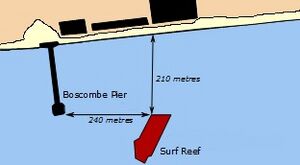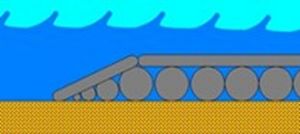Boscombe Surf Reef facts for kids
The Boscombe Surf Reef was a special structure built in the sea near Boscombe, England. Its main goal was to make the waves better for surfing. It was the first artificial surfing reef ever built in the northern part of the world.
Boscombe, which is part of Bournemouth, wanted this reef to be a unique attraction. The local council hoped it would make Boscombe beach famous. They also hoped it would bring many visitors every year. However, the reef was closed in 2011. In 2014, the area was changed into a "Coastal Activity Park." This new park focuses on activities like diving, windsurfing, and kitesurfing.
Contents
How the Reef Was Designed
The idea for the reef came from David Weight, a member of a local surf club. He first suggested it to the council in 1993. That's why some people called it "Weights Reef."
The reef covered an area about the size of a football field. It was located 225 metres (about 740 feet) away from the beach. The Boscombe Reef was built using large bags filled with sand. These bags are called geotextile containers. The reef used about 13,000 cubic metres of sand. It was designed only to create good surfing waves.
Before the reef was built, Boscombe had about 77 good surfing days each year. Surfers visited the beach about 5,000 times annually. The plan was for the reef to double the number of good surfing days. They hoped this would bring 10,000 surf visits. The first cost estimate for the reef was £1.4 million. But it ended up costing £3 million. The total cost for improving the whole beachfront area was £11 million.
Key Moments in the Reef's History
- 1999: Bournemouth Council started looking into the idea of building the reef.
- 2003: The council approved the plans for the surf reef.
- 2007: Permission to build the reef was finally given.
- August 2008: Construction of the reef began.
- November 2008: Work stopped for the winter season.
- April 2009: Construction started again.
- September 2009: The reef was finished, but it wasn't opened yet. Safety checks were needed.
- November 2009: The Boscombe Surf Reef was officially opened.
- March 2011: The reef was closed because of safety concerns.
- August 2011: Repair work on the reef began.
- April 2014: The area was re-branded as a Coastal Activity Park. It no longer focused mainly on surfing.
Building the Reef
The idea for the reef came about in the late 1990s. But it took a long time for construction to start. A company from New Zealand, ASR Ltd, finally began building it in June 2008.
The large sand-filled bags were made in New Zealand. They were then brought to Boscombe by a special boat called a barge. Workers filled these bags with sand that was already on the shore. About half of the reef was built during the summer of 2008. Work stopped for the winter and started again the next summer. The reef officially opened on November 2, 2009.
In 2010, the council announced that ASR would return to make changes to the reef. They wanted to improve the waves. In April 2011, one bag was removed and another was fixed. This was because a boat might have hit the reef. The reef was closed for safety reasons in March 2011. It remained closed through the summer.
ASR Ltd started repair work in August 2011. However, the work was delayed due to bad weather. ASR Ltd later closed down in September 2012. By September 2013, the reef was still closed.
In October 2013, the council received money from insurance for damage to the reef. They planned to fix the reef and reopen it in April 2014. The council decided not to spend more taxpayer money on making the reef better for surfing. Instead, they focused on making it safe for other activities. These included a dive centre and a dive and snorkel trail.
In April 2014, the area officially became the Coastal Activity Park. It now offers diving, kitesurfing, windsurfing, and beach sports like volleyball.
How the Reef Performed
In the first year and a half after it was built, the reef sometimes had good surfing waves. But many surfers were disappointed. A report in May 2010 said that the reef only met four out of its eleven design goals. The waves were shorter and not as consistent as planned.
Even with the problems, some local bodyboarders continued to use the reef. They used it both before and after it was closed for safety. However, by November 2014, many surfers had "given up" on the reef.



